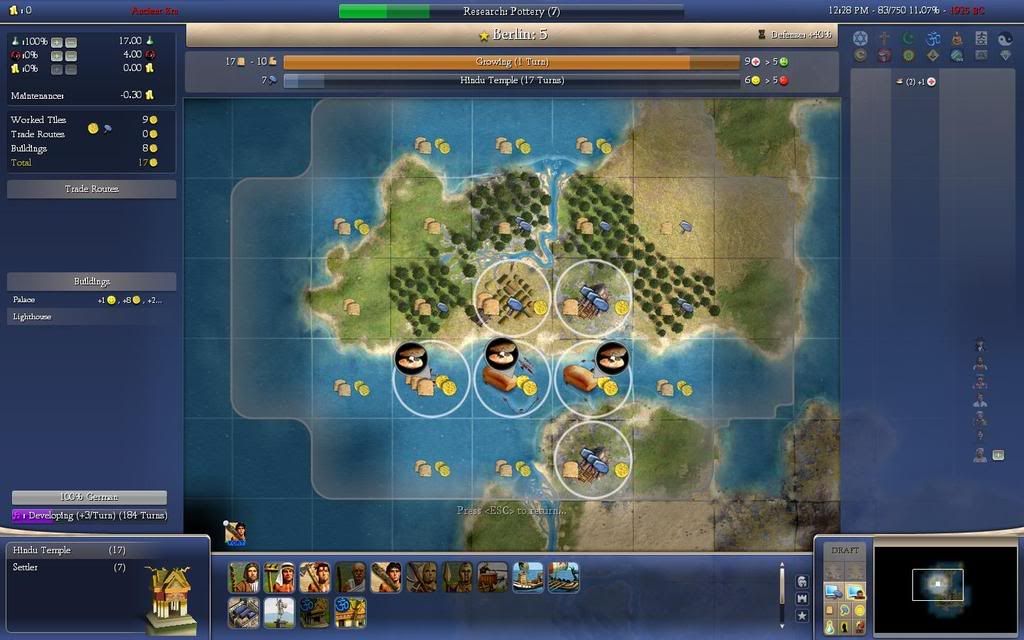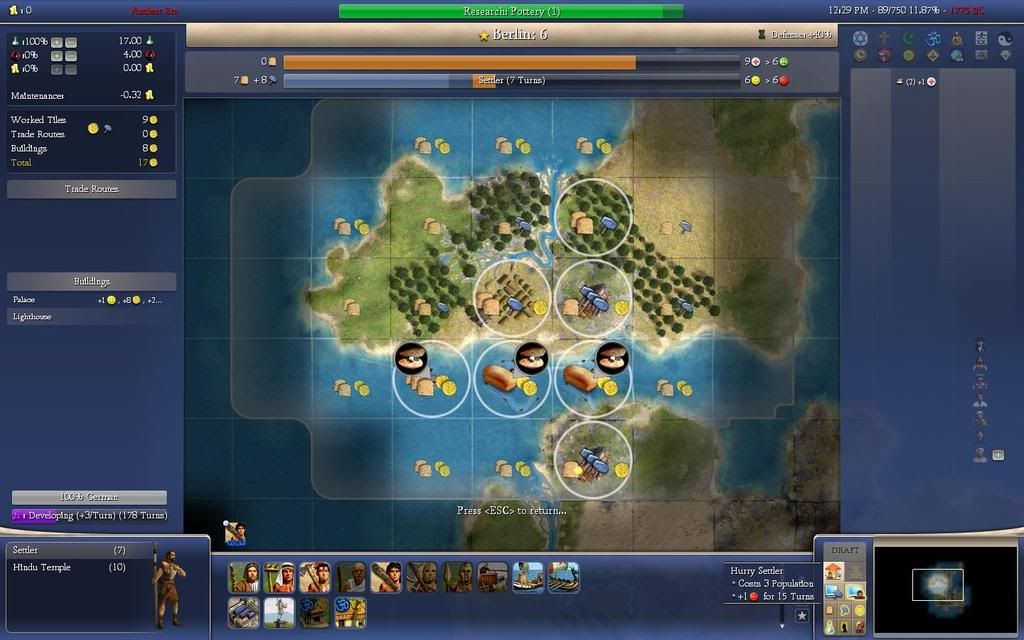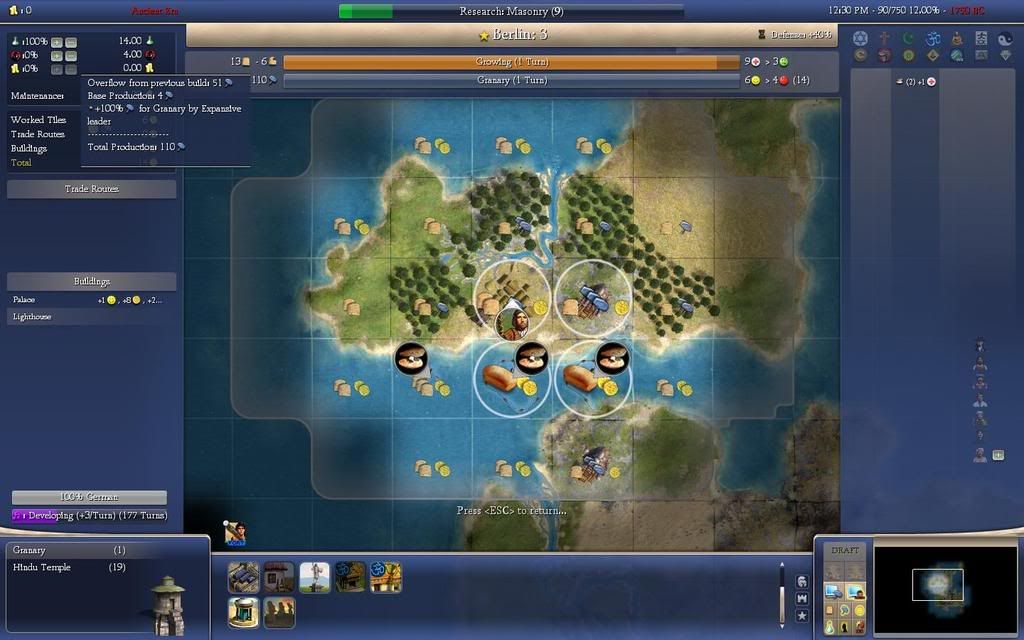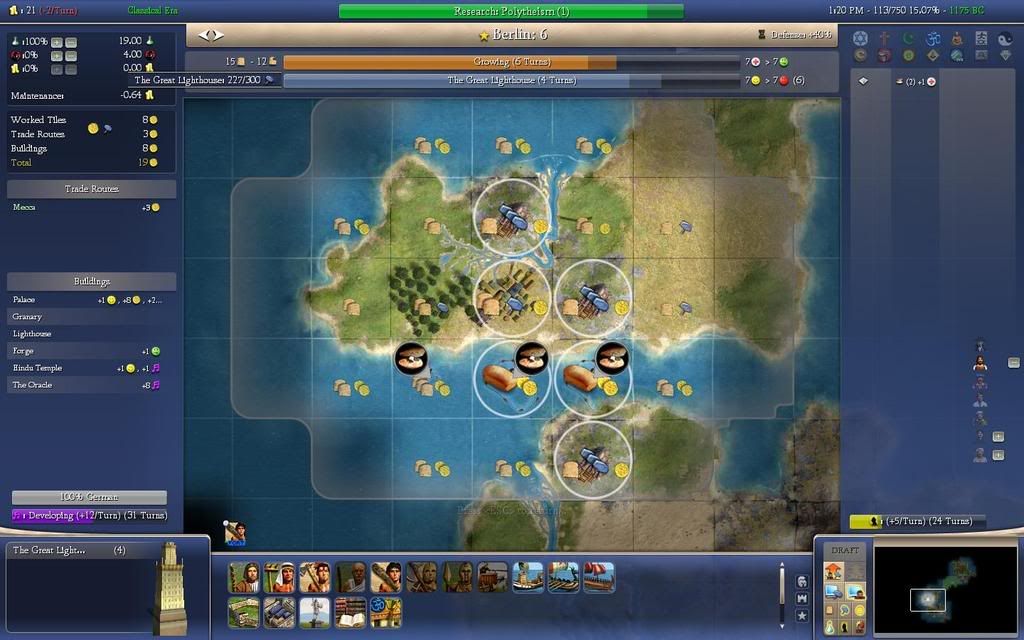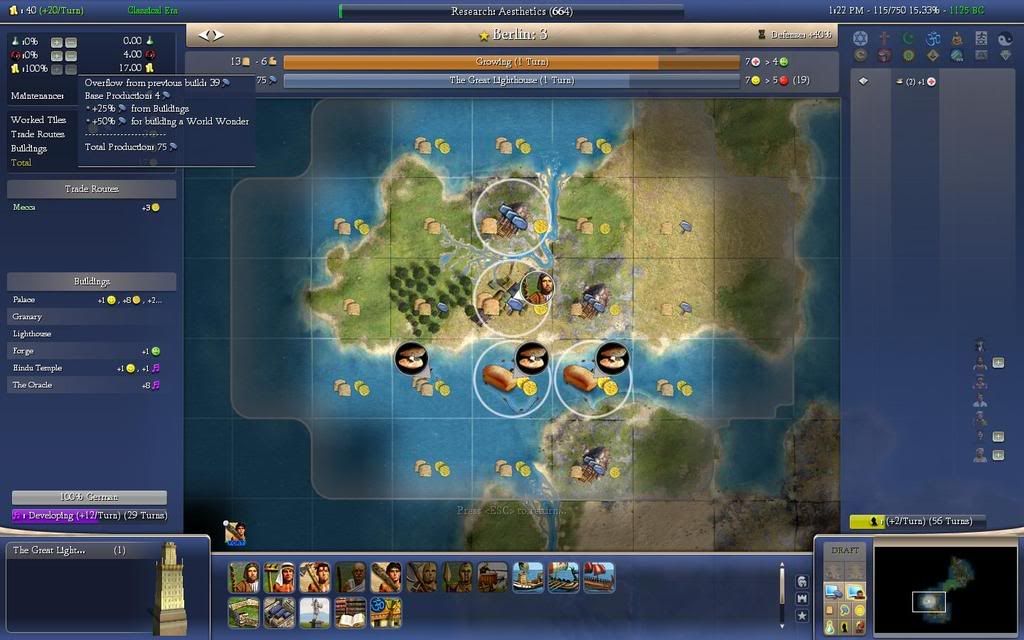So to give a preview of what is to come by the end of the round:
There were no negative events and no positives. The Oracle was built in 1450BC. The Great Lighthouse finished(as you will see) in 1125BC. The Temple of Artemis was completed in 675BC. The Colossus was completed in 440BC. The Great Library was built in 155BC. And now the Hanging Gardens has 66 hammers invested into it.
But back to the beginning. Since this is all about the power of the three pop whip, it is interesting to note that the settler that is partially built is already perfect for 3 pop whipping. Any more and he will be in 2 pop whip territory. Our first step is to spend 2 turns in anarchy adopting Hinduism and Slavery, after which we will put a hindu temple in the queue above the settler to grow while waiting for pottery to be ready.
The reason to do the anarchy now instead of later, is that our worker will be busy improving tiles while we are in anarchy, thus minimizing the number of turns we must work unimproved tiles.
Commerce is key at the moment as our bottleneck will be the speed with which we finish the research of pottery. As usual, the city governor can handle this if we know what to ask for:
The next turn, the south mine is complete and the city governor dutifully updates without our help:
The worker is ferried back over to the main island. He will mine the north hill then chop a couple of forests. Although it is painful to lose the forests, the early influx of hammers will ensure we get the key infrastructure built in addition to the wonders we desire.
The turn before Pottery is in we whip the settler (after making sure that we aren't killing too much commerce):
The turn after, we insert a granary into the queue. The overflow will build it in one turn:
I guess this is a good time to mention that I like to engage in binary research. Most of the time it is either 0% or 100% for me. My thoughts are (besides the previously mentioned rounding issues that may or may not still exist) that by getting the necessary gold first then deficit researching, you are minimizing the amount of time you hover around low gold totals. When you have too little gold, you are vulnerable to certain nasty events. For instance the forge fire, deforestation, or slave revolt events are all much more manageable if you have the money to pay them off.
But that is just an aside.
You will see we make Hamburg into a bustling and vibrant city. Not quite, but the commerce right now is really important and it isn't like there are a billion winners down there pre-improvement. It is building a lighthouse because the worker is sticking around up north until copper city is improved:
Alright, so not much happens between now and the beginning of the major micromanagement, so there are no screens. Essentially, the worker finishes mining the north hill, the Hindu temple finishes, and the oracle is sped along with the help of one of the chops. A forge is built a turn and then immediately whipped in Berlin and then the Great Lighthouse is started. The worker chops another forest into the Great Lighthouse and there isn't much to think about until we get to size 6.
Once we get to size 6 though, because the Great Lighthouse will be finished relatively soon, we can use the overflow of a 3 pop whip to speed it up possibly. Warning: math ahead.
First, we can see that a turn built into a Settler will produce 18 hammers (this is true whether the 6th "tile" is the clams or an engineer (thanks to the forge). I will choose the engineer when it is relevant because I value the GPP more than the commerce. Anyway that's another aside.
So 18 hammers from the turn of production prior to the whip. The whip will produce 135(1.25) ~ 168 hammers. The three tiles we work post whip while the settler finishes building will produce 12 hammers (+7F and +5 hammers).
So after all that production is in the Settler will end up with 198 hammers. So 49 of those will overflow, but when the forge is factored out (dividing by 1.25) that is 39. The tiles worked the following turn will produce 4 hammers and with the production bonuses our total hammers the turn after the whip will be (39+4)1.75 ~75. So the magic number for us is when the GLH is less than 75 hammers from completion:
So we build and whip the Settler here and voila, the turn after:
Yay!
During the rest of the round, the idea behind these types of calculations remained the same, but the numbers changed as we settled a Great Engineer and a Great Prophet or enjoyed resource production bonuses to certain wonders. And my screenshots got less dense.
End result was 6 cities and the wonders listed.
Copper city was founded with the Great Lighthouse settler and improved with a Forge and Barracks to start churning out Axemen at stagnated population 2. So the army is actually reasonable since that city came earlier.


 Please explain what you mean by "I don't know that REX around Saladin can keep up for more than a rounds" ?
Please explain what you mean by "I don't know that REX around Saladin can keep up for more than a rounds" ? move, especially given this marble site.
move, especially given this marble site. but the autoupdate thing is something I didn't consider and that I will look into. I'm looking at the new ATI HD 3870X2 if I do have to replace the card.
but the autoupdate thing is something I didn't consider and that I will look into. I'm looking at the new ATI HD 3870X2 if I do have to replace the card.


